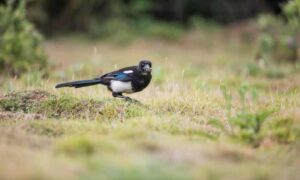
Over the past few weeks, a young magpie has become a regular visitor to my garden. While many froglets have already emerged from the pond, taking up residence in the long grass and stands of purple and yellow loosestrife, this clever corvid has realised that it can wade into the shallows and feast on the squirming late-hatched tadpoles. One afternoon, appetite satiated, the magpie hopped on to my raised vegetable bed and flopped down on a bare patch of soil, spreading its wings and fluffing its feathers. As the sun’s warmth penetrated its plumage, the bird fell into a trance‑like state, its head lolling.
After basking for a while, the magpie roused and began shuffling forwards and backwards, pecking at the ground and its still-splayed wings. Ants have nested in the corner of the bed and the bird appeared to be provoking them to defend their colony by spraying formic acid on its plumage. Many species engage in anting, but research examining the possible functions of this curious behaviour has failed to draw a definitive conclusion.
The most widely accepted explanation is that the chemicals released by the ants act as a natural fungicide and insecticide, inhibiting the growth of microorganisms and killing parasites that can cause irritation, damage the feathers and even cause life-threatening anaemia if present in large enough numbers. Other theories are that it’s a form of food preparation, allowing birds to consume ants without being harmed by ingesting the caustic substance, or that it’s an act of self‑stimulation, with the formic acid having similar euphoria-inducing or stupefying effects to alcohol or recreational drugs.
